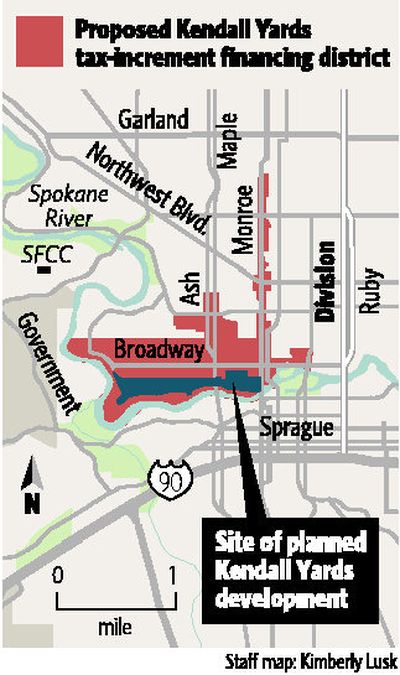Tax-funded subsidies can fall short

With the City Council on the verge of approving a tax-funded subsidy to help one developer, another who already has benefited from such a plan says it’s been a bureaucratic headache.
Few question the benefits of the Iron Bridge development, an upscale commercial office complex across Trent Avenue from Union Gospel Mission. But the “tax-increment financing” package used to subsidize water, streets and other infrastructure in the development hasn’t worked out nearly as well as predicted by the developer and city officials when it was approved in 2004.
After the other work was done, there wasn’t enough money for the project’s namesake pedestrian bridge over the Spokane River. And the city had to dip into its general fund for $10,000 to help with bond payments last year, because property taxes hadn’t increased enough in the neighborhood to cover that expense.
Although structured differently than the proposed deal for Kendall Yards, which is expected to win City Council approval tonight, the Iron Bridge project could provide lessons for the city and developers alike.
The developer says he wasn’t informed of the tax revenue shortfall, which he will be required to reimburse, until last week, when The Spokesman-Review started asking questions about the Iron Bridge project. City officials say they were still preparing the paperwork.
“If I had to do it all over again, I probably wouldn’t do TIF,” said Iron Bridge developer Kent Hull, explaining that he could have kept overall costs lower by financing the site improvements without city help.
Tonight, City Council will consider creating another tax-increment financing district, much larger than the $1.86 million approved for Iron Bridge.
A majority of council members have said they support the new district.
If approved, developer Marshall Chesrown would get 75 percent of the increased city and county property taxes generated by his 78-acre Kendall Yards development for the next 25 years – about $25 million in all, according to city estimates.
It would reimburse him about half the cost of preparing the site for housing and businesses on the north side of the Spokane River, west of Monroe Street.
But city leaders say there’s a big difference between Kendall Yards and Iron Bridge, which relied on tax-financed bonds.
At Kendall Yards, no public debt would be created, although the city might use the same tax district to issue government bonds for improvements in the West Central neighborhood bordering the upscale development.
At Iron Bridge, bonds sold by the city in 2005 for the project are supposed to be repaid from property taxes created by the development. Seventy-five percent of new tax collections are set aside for that purpose.
But when the first $21,375 payment was due Dec. 1, 2006, only $11,292 had been collected. So the city used its general fund to make up the difference, said city Budget Director Tim Dunivant.
This year, the district will raise $17,481 in taxes, but faces $42,750 in scheduled bond payments. The city will be paying off the interest and principal through 2029.
Hull predicts construction in the development will increase property values enough that the taxes will soon cover the cost of bond payments. Until that happens, he said, Iron Bridge will pay any shortfalls.
Hull said his company likely will reimburse the city this week for the current shortfalls. “I didn’t even know we were short until yesterday,” Hull said Friday.
Spokane Public Works Director Dave Mandyke said the city was processing paperwork to get payment.
“It’s not like we’re not going to get paid,” Mandyke said. “It’s a matter of when.”
And Spokane Chief Financial Officer Gavin Cooley stressed that taxpayers are protected by a letter of credit from Hull’s bank.
“There is zero exposure to the city,” Cooley said. “It’s all about benefits to the city, not about exposure to the city.”
Hull said he is looking to find grant money to turn the abandoned railroad bridge into a pedestrian link to the Centennial Trail. His company will pay for new decking at a cost of about $250,000, Hull said.
But the city-owned bridge also needs new paint that will cost about $1 million, partly because of environmental precautions to protect the river while the paint is being applied.
Donna McKereghan, who led the Logan Neighborhood Council when the project was approved, said she believes Hull acted in good faith when the bridge was discussed as part of tax-increment financing.
“Kent really wants to get it done,” said McKereghan, who is running for City Council.